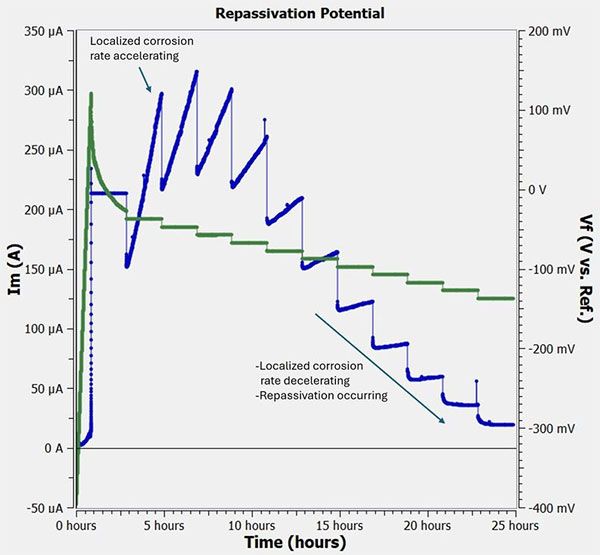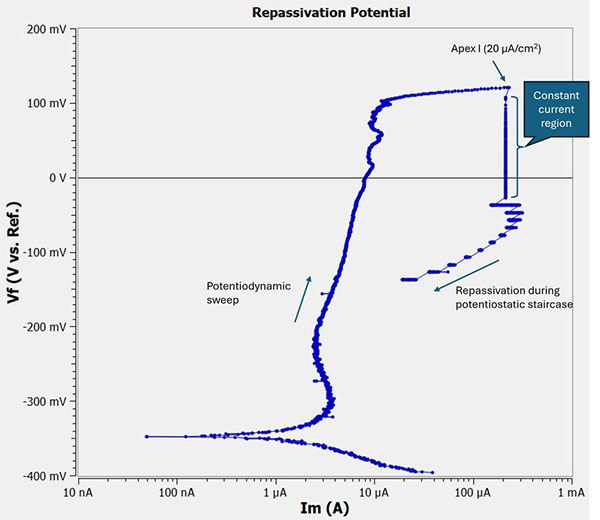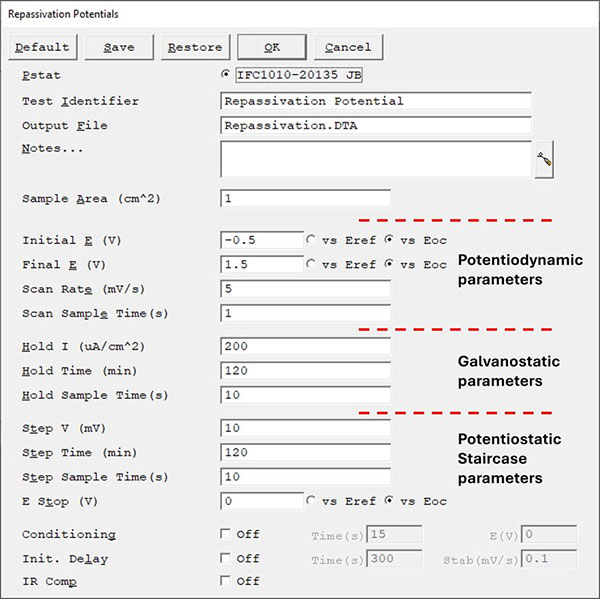THE Method for Crevice Corrosion Repassivation Potentials
Introduction
Localized corrosion, including crevice corrosion, is a leading cause of corrosion-induced failures. THE Method (Tsujikawa-Hisamatsu-Electrochemical Method) has been proposed to measure crevice corrosion repassivation potentials.
This protocol for studying the repassivation potential of a corroding crevice was first suggested by Tsujikawa and Hisamatsu in 1980.1,2 In the early 2000s, interest in corrosion rates of very long service-life alloys3,4 had rekindled interest in this protocol. Gamry Instruments became involved when a Gamry user asked us to prepare a special Framework™ script to automate the testing. Now, decades later, THE Method is a standard method (ASTM G192) complementary to localized corrosion tests using cyclic polarization (CPP; ASTM G61).
Gamry’s Solution
Thanks to Gamry’s Open-source Scripting approach to software development, the experiments were easily created in the Gamry FrameworkTM ExplainTM scripting language. Gamry’s Echem AnalystTM scripts, written in Microsoft’s Visual Basic® for Applications, were also easily modified. THE Method analysis has since been migrated to Echem Analyst 2TM.
Like the Critical Pitting Potential experiment (ASTM F746), THE Method involves a stimulation phase and a repassivation phase. The stimulation phase is a potentiodynamic ramp towards more positive potentials where anodic current is expected. The ramp stops when the current reaches a critical threshold (20 µA/cm2), indicating that crevice corrosion has begun. The sample is then galvanostatically held at this current density for a fixed time (2 h). At the end of this galvanostatic hold, the potential is measured. The cell is returned to potentiostatic control at this potential. The potential is then stepped towards the original open circuit potential in 10 mV increments.
During these potentiostatic steps the current is monitored. If the current continues to increase, that indicates that crevice corrosion is continuing. If the current does not increase when the potential is held for two hours, then the repassivation potential has been reached.

Figure 1. Potentiodynamic scan for THE Method. Potential is green, and current is blue. Sample area: 10.68 cm2
Figure 1 shows the potential (green) and current (blue) recorded during a typical run. In this plot, the potentiodynamic scan lasted for ~1 h, and terminated when the current density reached 20 µA/cm2. During the galvanostatic hold (hours 1 to 3) at this current density, the potential decays. At the end of the hold, the potential is stepped towards a more cathodic potential. We see that the current continues to increase during these steps. This is a clear indication that the crevice corrosion is still accelerating. Finally, when the potential is stepped to about -0.13 V, the current no longer increases, indicating that the repassivation potential has been reached.
Comparison to cyclic polarization
Many of our users are familiar with estimating a repassivation potential by running a CPP test. We thought it would be helpful to visualize the data in Figure 1 in the usual semi-log plot of potential and current (figure 2). The hysteresis on the return (after the apex I) is similar to what you would obtain with CPP on a sample under localized corrosion attack.
THE Method is many times longer than CPP and is not practical when under a time crunch. So why bother? One reason might be that the repassivation occurs at a lower current density, which affects the observed corrosion behavior4. The ability to vary the length of galvanostatic hold can also allow for precise rate control over the accelerated localized corrosion condition. This is not possible with CPP as both voltage and current vary with time.
Finally, figure 3 shows the breakdown of the parameters that need to be defined by the user.
The THE Method is described in ASTM Standard G 192. The THE Method is included with the Gamry DC105 DC Corrosion Technique Software.

Figure 2. Potentiodynamic scan for THE Method.

Figure 3. Parameters used to set up THE Method in Gamry Framework.
1. S. Tsujikawa and Y. Hisamatsu, Corr. Eng. (Jpn), 29, 37 (1980)
2.M. Akashi, G. Nakayama and T. Fukuda, Corrosion/1998, Paper 158, NACE International (Houston, TX, 1998).
3.V. Jain, D. Dunn, N. Sridhar and Lietai Yang, Corrosion/2003, Paper 03690, NACE International (Houston, TX 2003).
4.K. J. Evans, L. L. Wong and R. B. Rebak, “Determination of the Crevice Repassivation Potential of Alloy 22 by a Potentiodynamic-Galvanostatic-Potentiostatic Method,” Pressure Vessels and Piping Conference, American Society of Mechanical Engineers (San Diego, CA, July 2004).
Want a PDF version of this application note?
Please complete the following form and we will email a link to your inbox!



